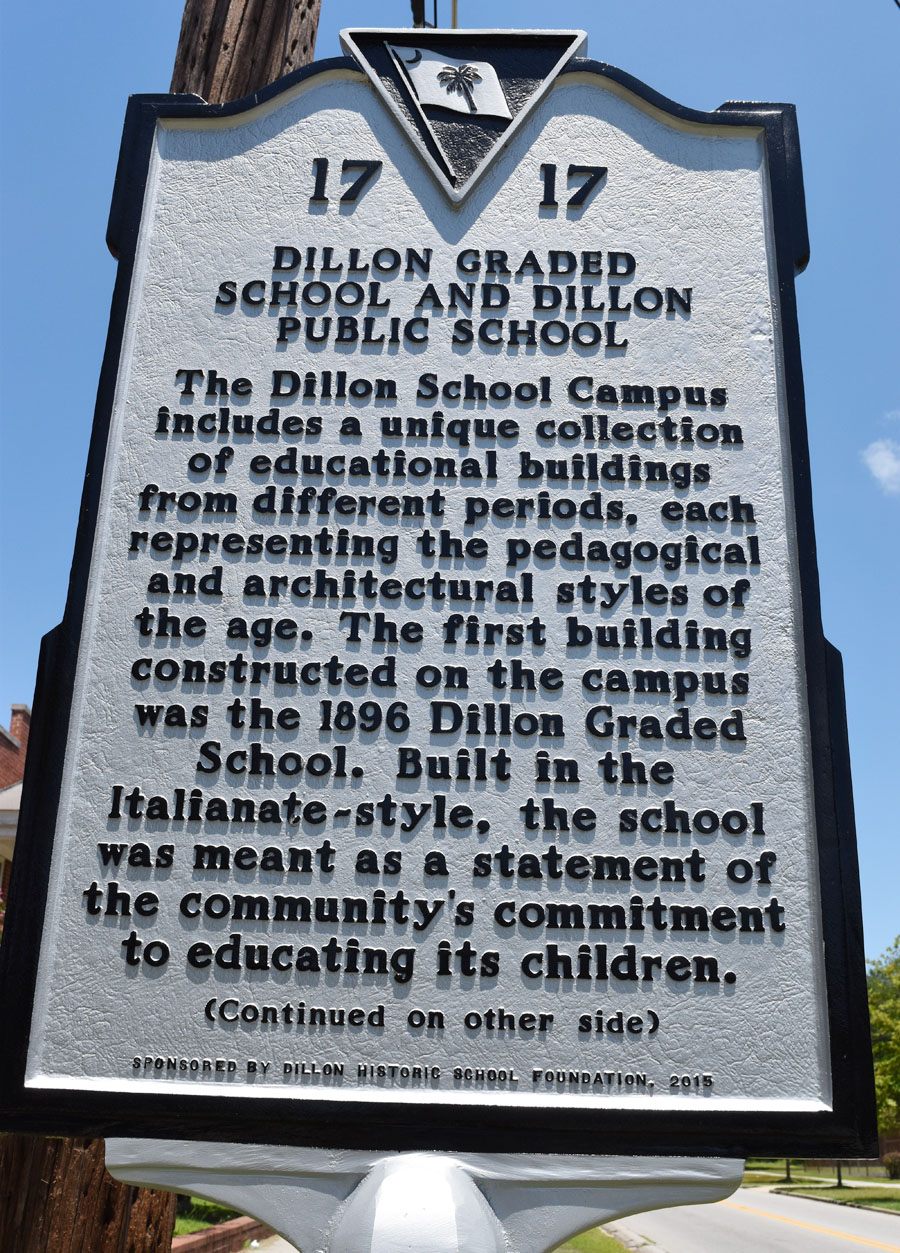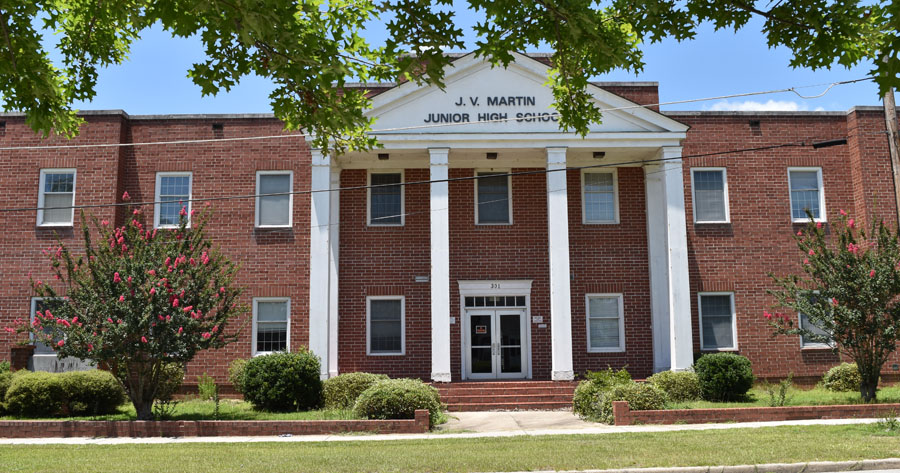
By Lorene Bridgers Arnette
In March, 2010, a group of Dillon citizens interested in saving and renovating the former Dillon High School/J. V. Martin Junior High School Auditorium organized with two major goals.
Their principal goal was to restore and return the use of the Auditorium to the Dillon Community.

Additionally they wanted to have the facility recognized as an important historic place. The Dillon Historic School Foundation (DHSF), originally titled the Dillon School Advocacy, began working on their first objective – evaluating the work needed for the restoration of the auditorium.
As the assessment continued, they also worked with the South Carolina Department of Archives and History and the National Park Service, a division of the United States Department of the Interior to have four of the buildings on the campus listed on the National Register of Historic Places. That goal was soon realized with approval in 2014, followed in June, 2016, by the installation of a Historic Marker in front of the campus. The group held a ceremony to celebrate the national recognition.
The buildings listed include: the Dillon Graded School, built in 1896, later renamed “West Elementary.”

This beautiful brick building with a white exterior is known locally as “The White Building.”
The other buildings listed also include the cafeteria wing constructed in the mid-1950s, the auditorium and gymnasium, both constructed in 1936 under the Roosevelt Administration’s Works Progress Administration (WPA), a public works program during the Great Depression Era.
Other goals achieved included attaining 501(c) (3) non-profit status from the IRS, meaning that all contributions to their restoration efforts are recognized as tax deductible, changing the name of the organization, and subsequently acquiring ownership of the auditorium from the local school district, Dillon District Four.

With ownership of the J.V. Martin campus came new challenges; however, the original goal of opening the auditorium is still primary for DHSF members.
Construction on the Dillon Public School began in 1912 as a simple two story building with classrooms on the first floor and an auditorium on the second. The red brick building was decorated with white trimmed windows that lined its entire front. A concrete plaque was placed above the double doors of the building that proudly read “1912 .” Later the gym and auditorium were built, using WPA funding. These facilities, designed by architect Henry Dudley Harrell, flanking the original school classroom building, feature large arched windows lining the sides of both wings allowing light to flood inside. The Auditorium includes two stories and seats over one thousand (1,000) people.
The auditorium is completely constructed of wood with perfect acoustics in all areas of the auditorium due to the wood interior and the slightly convex structures of both the ceiling and the rear wall that create an unequaled acoustical quality. The extraordinary view of the 60-foot wide stage from every seat of both the main floor and the balcony are continued evidences of the superior design and construction supervised by architect Harrall.
Over the years the imposing stage was home to all kinds of grand productions. The inaugural performance was a musical concert with guest artists Edgar Alden, violinist, and Miss Aileen McMillan, pianist, both faculty members at Meredith College, Raleigh, North Carolina. In addition, local participation that evening featured a Community Chorale and Miss Rebecca Field Henslee, Dillon native and a renowned pianist and organist.

Other performances over the years included noted pianist, Ossip Gabrilovitch, a Russian-born American pianist, conductor and composer, trained in piano and composition at the Saint Petersburg Conservatory, with Anton Rubinstein, and later, in Vienna. He was married to Mark Twain’s daughter, Clara Clemens, a singer who appeared with him in recital. He performed in Dillon in 1926, after escaping from World War I Germany in 1914, with the assistance of the Bavarian Archbishop, who later was designated Pope Pius 12th.
The multiple-award winning Dillon High School Band (“The Marching Cats”) concerts, under the direction of the late Helen Culp, were highlights of the local community’s year. The auditorium was home to hundreds and hundreds of concerts over the years and was always filled to overflowing with family, friends, fans, and fellow students. Many of Miss Culp’s students went on to successful music careers in their own right.
In addition, locally-grown artists have graced the stage, including: Michael Lee as featured piano soloist with the Columbia Philharmonic Orchestra; Robert MacDonald, pianist and composer; Sara Ann Noles, renowned as the foremost Gilbert and Sullivan soprano east of the Mississippi; Jimmy Woodle, gifted pianist, now living and teaching in Florida; Elizabeth Tolar, gifted soprano soloist, and many others. In addition to musical presentations the stage has been home to dramatic productions, including “The Golden Land,” a play recounting the origins of Dillon County, written by Pulitzer Prize-winning playwright Paul Green, as well as local recitals, little theatre productions, and touring companies performing the great plays and musicals of Broadway.
The academic building served the community as the Dillon High School, from 1920 for fifty (50) years, with an original enrollment of 82 students. In 1970, a new high school was constructed and the facility became a middle school and was renamed “J. V. Martin Junior High School,” in memory and in honor of a long term, and revered District Superintendent, Mr. Joseph V. Martin, who served the school system for 29 years. Ten years later, on November 8, 1980, the central portion of the main building, between the added east and west wings tragically burned to the ground. The administrative office, the library, and 16 classrooms were obliterated. Fortunately, the auditorium and gymnasium survived the fire.
When the current junior high school, Dillon Middle School, was constructed, the J. V. Martin campus was left unused. At that time, the Dillon Historic School Foundation (DHSF) renewed their dream of reviving the school’s esteemed auditorium.
The group consists of approximately 40 members with about 13 primarily active members in the Dillon community. The members and support have stretched nationally as well as internationally. The vision for the auditorium is returning its use to the community of Dillon for school performances, dance recitals, church functions, and even political group meetings. Early in his 2007 successful run for election as President, Barack Obama made a campaign stop and spoke at J. V. Martin to an interested group of local citizens.
Being placed on the National Register does not guarantee that the buildings permanently stand, but it certainly does open the community’s eyes to the importance and significance the school holds.

DHSF has achieved tremendous success since their beginning in 2010, but not without facing obstacles. Restoring old buildings can be challenging. Outdated wiring and lighting, mold, broken ceilings and disintegrating floors pose serious repair challenges of their own. Despite these difficulties, with the help of the community’s physical and financial help, restoration is on its way. A major undertaking, replacing the auditorium roof, has been completed and the group looks forward to the next project to tackle.
Local businesses, area industries, and private citizens are key to providing the financial support needed to reopen the auditorium’s doors. DHSF actively encourages the Dillon Community to bring its own rich cultural past to the present by supporting their efforts. As their brochure reads, “Historic Places give us roots, teach and inspire us, enhance community pride, and make communities more attractive. They encourage tourism and are the valuable assets necessary for downtown revitalization.” It is quite clear that the school’s successful restoration is meaningful to not only the members of DHSF, but also to the entire community.
As the late Miss Helen Culp, Dillon High School’s beloved and prestigious band director said, “After many years of use, multiple repairs are needed to return this fine ‘Old Lady’ to her former beauty and usefulness.”








